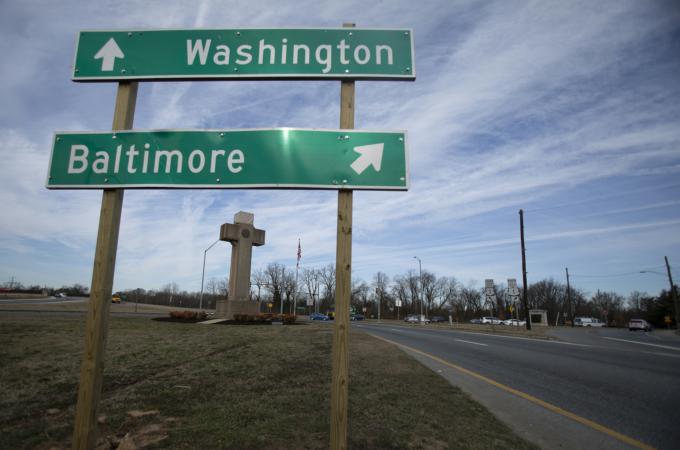Reflections on the Blandensburg Cross
Is it too much to ask a court which must make a judgment to get straight the facts about which it judges?
Let's begin with a cross which marks a soldier's grave. It has multiple functions. First, it shows that the ground has been made holy by the soldier's sacrifice. "We can not dedicate -- we can not consecrate -- we can not hallow -- this ground," Lincoln said at Gettysburg, "The brave men, living and dead, who struggled here, have consecrated it, far above our poor power to add or detract." The cross does not itself consecrate the ground; it marks that the ground has already been consecrated. Curiously, other symbols besides the cross don't convey consecration as well. The star of David does not function in that way, for instance; rather, it makes a statement about the religion of the soldier who died.
Once, when I visited the battlefield of Manassas, some young men who were visitors from another country came from the parking lot playing soccer. I wanted to shout, "Stop, this is a holy place!" But I lacked courage, or clarity. Perhaps what they did was innocent or uninformed. But certainly if they wanted to show contempt for America's soldiers they would have done nothing different.
Second, the cross is thought to invoke divine assistance and even protect, a fact emphasized in the burial ritual of Brixen, where the priest signs the grave with a wooden cross and then planting it at the head of the grave says "May the sign of Our Lord Jesus Christ be upon you, who has redeemed you in his image, and may this cross prevent the enemy angel from attacking you through eternity."
Third, by the cross we place the highest possible interpretation on the soldier's death, whether he grasped it fully himself or not. How under-appreciated is the sacrifice of life of a soldier today! He is indeed conformed to the sacrifice of the Lord if he gives up his life, alongside his comrades, for his country in a just war. The "free exercise of religion" surely extends to the interpretation one places on one's death.
Now consider the towering cross of concrete placed in 1925 at a meeting of roads in Bladensburg as a memorial to the soldiers of Prince George's County, Maryland, who fell in the Great War.
There are many WWI memorials around the country. No one knows for sure why this one was made in the form of a giant cross. But the best guess is that the cross is meant to reproduce, and signify by reproducing, the simple crosses which mark the graves in cemeteries at the great battlefields of WWI. (Type "Somme American Cemetery" into a search engine, and you will see the point.) In 1925, it was not possible to transport remains to the States or easy for relatives to visit Europe. The big Blandensburg cross in a sense takes us there and unites us with them. One might virtually visit their graves by visiting an image of their graves.
Now, as such, the Blandensburg cross is a sign of a sign, as if someone visited the grave of a relative at Arlington National Cemetery, took a picture of the cross marking the grave, and placed a print of the cross on the refrigerator for everyone to see. Here's an obvious point which the Supreme Court never took into account: a sign of a sign has a different function from the sign.
Not that they even get the original function right. It's nonsense to say as Justice Ginsberg wrote in her dissent, in the manner of a generous concession, that "in a cemetery, the 'privately selected religious symbols on individual graves are best understood as the private speech of each veteran.'" We've seen that the cross at least has different and far more powerful functions. (Ginsberg didn't even see that, in quoting a claim about the grave of a "veteran," she was saying something which missed the mark entirely for a fallen soldier.)
But without further argument we cannot ascribe the function of the sign to the sign of the sign: otherwise the Court's use of the words "Blandensburg Cross" would be just as suspect, as an entanglement in religion by government, as the cross itself.
I haven't even touched upon the meaning in the act of erecting the monument. Soon after it was erected, if not immediately, it was referred to as the "Peace Cross," not as a euphemism, but because the people who erected it believed that, as a fundamental truth of human life, all peace had to be won through battle requiring sacrifice to the point of death. The quotation on the cross from President Wilson expresses this view, by ironically affirming that some things are higher than peace: "The right is more precious than the peace; we shall fight for the things we have always carried nearest our hearts; to such a task we dedicate ourselves." At the base of the monument are the words, "Valor, Endurance, Courage, Devotion" -- put there by a people who knew what these were and believed in them.
I drive by the Bladensburg cross about once a week. I have come to view it as like one of those monoliths on Easter Island, left by a lost civilization. This monolith I think judges us: we are hardly in a position to stand in judgment of it.
- Michael Pakaluk is Professor of Ethics and Social Philosophy in the Busch School of Business at The Catholic University of America. His book on the gospel of Mark, ‘‘The Memoirs of St. Peter,’’ is available from Regnery Gateway.



















